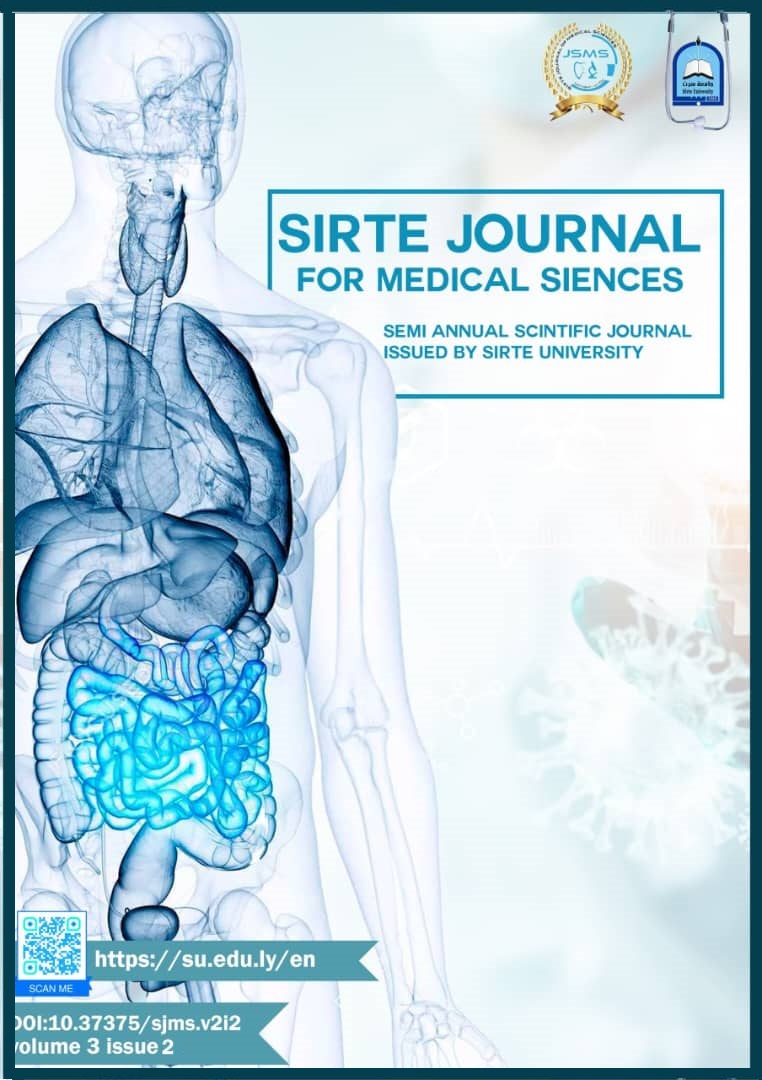Pregnancy out comes after assisted reproductive technology (Derna / Libya)
DOI:
https://doi.org/10.37375/sjms.v3i2.3167الكلمات المفتاحية:
Assisted reproductive technology، Perinatal health, pregnancy outcomes، congenital anomaliesالملخص
Background: Studies the outcome of pregnancy after assisted reproductive technologies (ART) pregnancies report heterogeneous results. Despite the success of ART to overcome infertility, concern is growing regarding both its safety and its effect on maternal and child health.
objective: The aim of this study is evaluation of pregnancy outcome (maternal and fetal) after ART.
Methods: A population-based birth prospective cross- section observational study was carried out among pregnant women by ART & expected to deliver in 2020 to 2022 at Al wahda hospital / Derna, maternal results included gravidity difficulties and weight gain during pregnancy.
Results: The study includ 100 pregnant women after ART. Adjusted examines displayed that, more than 90% of pregnancies were multiple pregnancy. The OHSS was positive in 45.0%. The majority of the patients (97.0%) had anemia during pregnancy. The cervical cerculage done in 46.0% of the pregnant women.
Conclusion: the major bad effect on the child-health results is owing mostly to the increase occurrence of several pregnancies and not because of ART.
المراجع
- da Silva S.G., da Silveira M.F., Bertoldi A.D., Domingues M.R., Dos Santos I.D.S. (2020): Maternal and child-health outcomes in pregnancies following Assisted Reproductive Technology (ART): a prospective cohort study. BMC Pregnancy and Childbirth, 20, pp. 1-8.
- O’Shea L., Hughes C., Mocanu E.V. (2015): Advanced maternal age and assisted reproductive technologies in an Irish population. Irish medical journal. pp. 108.
- Sumners J., Ecker J.L. (2016): Perinatal risks associated with assisted reproductive technology. Obstetrics and Gynecology, 128(3), pp. E61-E68.
- Klitzman R. (2016): Deciding how many embryos to transfer: ongoing challenges and dilemmas. Reproductive biomedicine & society online, 3, pp. 1-15.
- Lee A.M., Connell M.T., Csokmay J.M., Styer A.K. (2016): Elective single embryo transfer-the power of one. Contraception and Reproductive Medicine, 1, pp. 1-7.
- Bergh C., Kamath M.S., Wang R., Lensen S. (2020): Strategies to reduce multiple pregnancies during medically assisted reproduction. Fertility and Sterility, 114(4), pp.673-9.
- Johnson J.A., Tough S., SOGC Genetics Committee. (2012): Delayed child-bearing. Society of Obstetricians and Gynaecologist of Canada Committee Opinion, J Obstet Gynaecol Can 34, pp. 80–93.
- Gibbons W.E., Cedars M., Ness R.B. (2011): Toward understanding obstetrical outcome in advanced assisted reproduction: varying sperm, oocyte, and uterine source and diagnosis. Fertil Steril 95, pp. 1645–9 e1641.
- Qin J., Wang H., Sheng X., Liang D., Tan H., Xia J. (2015): Pregnancy-related complications and adverse pregnancy outcomes in multiple pregnancies resulting from assisted reproductive technology: a meta-analysis of cohort studies. Fertil Steril. 103(6), pp. 1492–508.e1491-7.
- Wen S.W., Leader A., White R.R., Léveillé M.C., Wilkie V., Zhou J. (2010): A comprehensive assessment of outcomes in pregnancies conceived by in vitro fertilization/intracytoplasmic sperm injection. Eur J Obstet Gynecol Reprod Biol 150, pp. 160–5.
- Celeste L. (2017): Are children born from singleton pregnancies conceived by ICSI at increased risk for congenital malformations when compared to children conceived naturally? A systematic review and meta-analysis.” JBRA assisted reproduction. 21(3), pp. 251-259.
- Davies G.A., Maxwell C., McLeod L. (2010): SOGC Maternal Fetal Medicine Committee; SOGC Clinical Practice Obstetrics. Obesity in pregnancy. Society of Obstetricians and Gynaecologists of Canada Clinical Practice Guideline. J Obstet Gynaecol Can. 32, pp. 165–73.
- Hansen M., Kurinczuk J.J., de Klerk N., Burton P., Bower C. (2012): Assisted reproductive technology and major birth defects in Western Australia. Obstet Gynecol. 120(4), pp.852–63.
- Vasario E., Borgarello V., Bossotti C., Libanori E., Biolcati M., Arduino S. (2010): IVF twins have similar obstetric and neonatal outcome as spontaneously conceived twins: a prospective follow-up study. Reprod Bio Med Online. 21(3), pp. 422–8.
Lei L.L., Lan Y.L., Wang S.Y., Feng W., Zhai Z.J. (2019): Perinatal complications and livebirth outcomes following assisted reproductive technology: a retrospective cohort study. Chin Med J. 132(20), pp. 2408–16.
Moini A., Shiva M., Arabipoor A., Hosseini R., Chehrazi M., Sadeghi M. (2012): Obstetric and neonatal outcomes of twin pregnancies conceived by assisted reproductive technology compared with twin pregnancies conceived spontaneously: a prospective follow-up study. Eur J Obstet Gynecol Reprod Biol. 165(1), pp. 29–32.











